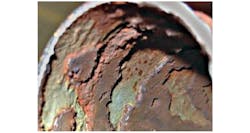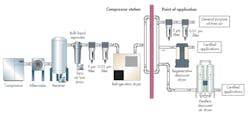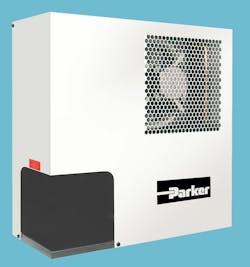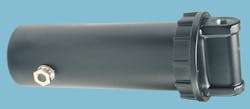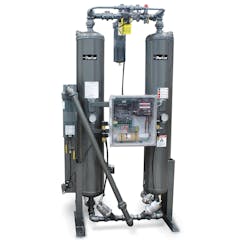Clean, Dry Air Is Fundamental to Productivity
Download this article as a .PDF
Just like electricity, natural gas, and water, compressed air represents a critical resource in a broad array of industrial environments and countless applications—everything from familiar applications like vaporizing paint in a body shop to more technically advanced ones like lithography processes in semiconductor fabrication. However, simply preventing leaks in a compressed air system to maintain the required level of pressure is far from sufficient.
Just as with many other critical resources, facility managers must take steps to ensure the quality of the compressed air consumed in their operations to avoid substandard product quality; unplanned downtime and loss of production; equipment damage; and the potential for danger to employees and the facility itself.
You Can’t Stop the Presses
Recently, we were asked for advice on a pneumatic system in a newsprint press facility in coastal Florida. The hot, humid location, the wood pulp fibers in the atmosphere, and inadequate pre-filtration meant their compressed air system was choked with moisture, scaling, and dirt in the distribution lines a mere five years after being put into service. However, given the demand to keep the presses running, shutting the whole system down to replace all the piping was impractical.
Instead, we first focused on preventing contamination from affecting the most critical areas of the facility. Filters, dryers, and liquid separators were added to protect applications such as the press roll and the ink drying area. The next step was to work our way backward and ensure the compressor intake was located in a clean environment to prevent the contaminants from entering the system.
A compressed air system that produces clean, dry air is crucial to the ongoing productivity of any pneumatic system. Too often, cutting corners will produce a compressed air system that’s contaminated by water, oils, particulates, or micro-organisms, which will lead inevitably to higher expenses for equipment maintenance and replacement later—as well as the potential for contaminated products.
Sources of Contamination
By its very nature, the process of producing compressed air leads to contamination and condensation. Without adequate filtration and drying, the compressed air in the system will incorporate all the contaminants present in the ambient environment. When moist, oily, dirty air is drawn into a compressor, it will still be moist, oil-saturated, and dirty after compression. In fact, compressing air generates heat, increasing the air’s temperature and increasing its capacity to hold moisture.
Industrial compressed air systems are susceptible to a wide range of contaminants:
- Atmospheric dirt. Every cubic meter of air in a typical industrial environment contains millions of undesirable particles, particularly in settings that involve processes that produce dust or smoke. Roughly 80% of these particles are smaller than 2 microns, which means they typically aren’t captured by a compressor’s intake filter, so they can be sucked directly into the facility’s compressed air system.
- Water vapor and condensed water. Atmospheric air inevitably contains some level of water vapor. As mentioned previously, compressed air’s ability to hold water vapor depends on its temperature: The higher the compressed air’s temperature, the more water vapor it can This vapor becomes a problem when it condenses into liquid water at various points in the system. This happens as the air is further cooled by the air receiver and piping and the expansion of valves, cylinders, tools, and machinery.
- The quantity of water in a compressed air system can be surprising, and a lot more than you might imagine. A small compressor and refrigeration dryer combination, operating in typical climatic conditions, can produce thousands of gallons of liquid condensate in a year. The amount of condensate increases dramatically in warmer, more humid climates or when large compressors run for extended periods. Whatever form it takes, water must be removed from a compressed air system to allow it to run correctly and efficiently.
- Rust and pipe scale. As the compressor operates, it can produce metallic wear particles; the combination of water and iron encourage rust and pipe scale to form (Fig. 1). Over time, this contamination will build up on the inner walls of the compressed air distribution system. This sometimes reduces the pipes’ capacity or flakes off to cause blockages in directional control valves and orifices—requiring expensive maintenance and downtime, and potentially contaminating the finished product.
- Micro-organisms. Just like microscopic dust particles, mold spores, pollen, bacteria, and viruses can be drawn into a compressed air system through the compressor’s intake filter. The warm, moist air inside a system provides an ideal growth medium for micro‐organisms. Ambient air typically contains thousands of micro‐organisms per cubic meter. It only takes a few to slip past the filtration system into a clean environment, a sterile process, or a production system to cause enormous damage by affecting product quality; often, they can render food, beverages, or pharmaceuticals unfit for use and force a product recall.
- Liquid oil and oil aerosols. Oil is often used in the compression stage of air compressors for sealing, lubrication, and cooling. This oil can transfer into the compressed air system in the form of liquid oil or aerosols. When combined with water vapor in the system, it forms a highly acidic mixture that can cause rapid wear on the compressed air storage and distribution system, tools, and production equipment, as well as the finished product.
- Oil vapors. Typical oil vapor concentrations range from 0.05 mg to 0.5 mg per cubic meter of ambient air. Unburned hydrocarbons from vehicle or motor exhaust or nearby industrial processes can be drawn into the compressor intake and combine with vaporized oil from the compression stage of a lubricated compressor. After these oil vapors are drawn into the compressed air system, they can cool and condense, causing similar contamination problems as liquid
A Two-Pronged Approach to Compressed Air Quality
The first principle of maintaining compressed air quality is that it should be treated prior to entering the facility’s distribution system and at each point of use. This system design approach (Fig. 2) allows for the most cost-effective solution to system purification by getting rid of contamination residual in the distribution system, all the while ensuring the most critical areas are exposed only to the most highly treated and purified air. In most environments, a single compressed air system supplies air to multiple applications; although the purification equipment specified in the compressor room stays the same, the point-of-use air quality requirement will vary depending on the application. To meet exacting air quality requirements, a careful approach to system design, commissioning, and operation must be employed. More information on ISO 8573, the standard for the quality of compressed air, is available at http://www.iso.org.
A growing range of drying technologies are available, many of which are incorporated into the compressor itself. Although some applications require only a single component to achieve the appropriate level of purity, most demand a multi-step circuit design with several progressively aggressive purification steps.
Current technologies include:
- An aftercooler is designed to reduce the temperature and water content of the compressed air. Air saturated with water vapor can leave a compressor at temperatures from 240°F to 400°F (116°C to 204°C). Without an aftercooler, the air will cool to close to room temperature in the distribution lines and the water vapor will condense into liquid water throughout the air distribution system. About two-thirds of the total water content of the air will be condensed when its temperature drops to 100°F (38°C).
Bulk liquid separators. These can be installed to remove bulk liquid at any point within the compressed air system to protect filters, refrigeration dryers, and heatless regenerative desiccant dryers. They employ centrifugal separation technology; air enters an inlet with a set of fixed vanes, forcing the air to spin inside the vessel. Bulk condensate is removed due to directional changes of the airstream, velocity changes, and centrifugal action of the air rotation.
Particulate filters. These remove solid particle contaminants down to 5 µm and separate bulk liquids.
Coalescing filters. This filter type removes liquid aerosols and submicron particles (not vapors) down to .01 micron in size. It typically employs a mesh and metal screening to allow the moisture or contaminants to come together inside it before gravity causes it to drain itself.
Refrigeration dryers. As their name suggests, refrigeration dryers (Fig. 3) work by cooling the air and condensing the water vapor, which is later expelled through a drain. Although they are ideal for general-purpose applications, this type of dryer does not achieve dew points below freezing, typically providing pressure dew points of +38°F (+3°C), +45°F (+7°C), or +50°F (+10°C). Refrigeration dryers take the heat from the inlet air, then use it to reheat the air at the outlet. The dried air is returned to the air line at ambient temperatures. This process eliminates “sweating” that occurs with exposure to cold pipes or when working in humid conditions.
Self-contained refrigeration dryers cool the refrigerant condenser and automatic cooling systems with fans to provide the precise level of heat exchange required by the air being used. These systems keep the delivered air at a constant humidity and dew point. Coalescing filters located upstream prevent oil/liquid water from entering the dryer. Cooling surfaces coated with oil decrease efficiency; water absorbs some of the system capacity.
Refrigeration dryers are unsuitable anywhere that piping is installed in ambient temperatures lower than the dryer dew point. For example, it would be inappropriate to employ a +37°F (+3°C) dryer in an installation that uses outside piping where the outside temperature is lower than +32°F (0°C).
Adsorption (desiccant) dryers. These dryers are used in applications where very dry air is required. They are typically installed downstream from the aftercooler and/or the refrigeration dryer. Inline adsorption dryers (Fig. 4) feature a desiccant material contained within a vessel. When the compressed air passes through the vessel, any water vapor included is absorbed by the desiccant material. The desiccant must be replaced periodically; it can be dried and returned to service. Because of this, they are used in “point of use” applications having intermittent flow.
Heatless regenerative desiccant dryers take advantage of the dry air generated in the drying process to remove water vapor from the desiccant material. Basically, this dry air is rerouted back and forth at regular intervals between two desiccant beds. When dry air passes over one bed, the water vapor evaporates from the desiccant into the dry air system, and the moisture-laden air is later vented to atmosphere. Once the first bed is dry, the dry airflow is switched to the second bed, and the process repeats.
Some desiccant dryers have electric heating elements that accelerate drying of the desiccant during the rest cycle. In comparison, heatless desiccant dryers operate lower electric utility costs. Heatless desiccant dryers (Fig. 5) reduce the compressed air system’s dependence on costly utilities, particularly steam, electricity or other heat sources. Running a heatless desiccant dryer takes minimal electricity. If their size allows, these dryers are often located near the point of use to deliver instrument-quality air for critical applications.
When reviewing desiccant dryer specifications, keep in mind that the air’s temperature after it passes through an adsorption dryer isn’t the same as its dew point. This is advantageous because a pressure dewpoint of –15°F (–26°C) or better will not only prevent corrosion but inhibit the growth of microorganisms within the compressed air system.
Oil or water entering a desiccant dryer will adversely affect its performance and/or destroy the desiccant material inside it. To protect the dryer, system designers recommend installing a coalescing filter upstream from it. They also suggest installing a filter downstream from the dryer to prevent any carryover of the desiccant to downstream equipment or processes.
Membrane dryers. Selectively permeable membrane materials made up of bundles of hollow fibers are an excellent medium for producing dry air from standard compressed air. As compressed air is forced through the center of these fibers, water vapor passes through their walls. Some of the dry air (purge flow) is redirected along the outside of each hollow fiber, which carries away the moisture-laden air so it can be expelled into the room atmosphere. The remainder of the dry air is piped to the point of use of the application. Some membrane dryers are designed to be located near the point of use to supply compressed air with dew points down to –40° to +35°F (+2°C), depending on the flow. Just as with refrigeration and desiccant dryers, it’s advisable to install coalescing filters upstream from a membrane dryer to avoid saturating the membrane with water or coating it with oil. If that happens, it will seriously inhibit the membrane drying function.
Although all the drying technologies play a role in compressed air system design, refrigeration, desiccant and membrane dryers are often overlooked enough though they offer economical, compact solutions. Some facility managers try to save economize by not installing point-of-use dryers, but they would be wise to evaluate the latest dry air products. The newest offer affordable, flexible, compact designs with significant benefits that increase financial value.
Creating Clean Dry Air Solutions
A manager’s decision to install a point-of-use dryer is based on cost, fit, and function. But the time and expenses saved in maintenance, reliable system performance, and higher air quality are all reasons to consider installing a dryer. To invest cost-effectively, remember these general principles:
Dryness is relative. To avoid freezing, the dew point of the compressed air should be approximately 20°F (–7°C) lower than the lowest ambient temperature.
Inlet temperature is a key factor. A reduction of 20°F (–7°C) cuts humidity in the air by half.
Avoid over-specifying and under-specifying. Attempting to dry the entire compressed air supply in a factory to dew points less than –40°F is both wasteful and impossible. Instead, subdivide the compressed air supply by application, treating each end use point as needed to provide appropriately dry air for the applications it’s meant to serve. At the same time, remember that wet, dirty air will cost money in maintenance time and supplies, downtime, and lost product.
Avoid potential problems. A drying system with only an aftercooler and a coalescing filter could create condensation problems downstream from the aftercooler. If the air is still saturated with water vapor, it will probably condense if the ambient air’s temperature is lower than the compressed air temperature.
Refrigeration dryers are ideal for general-purpose applications. These dryers don’t achieve dew points below freezing.
Desiccant dryers are ideal for applications requiring dry air –40° or below. Typically, applications below 1,000 scfm work best with heatless desiccant dryers; applications higher than 1,000 scfm work best with heated dryers.
Membrane dryers are ideal for applications that require dry air down to –40°. No electricity is required; with proper pre- and post-filtration, these dryers are practically maintenance free.
To protect equipment, save money, and optimize your energy consumption, always work with a supplier that understands both your processing requirements and the air drying and filtering products appropriate to address them. As tempting as it may appear, resist the urge to cut corners. Make sure you size equipment properly with appropriate dew points and flow to preserve assets, eliminate headaches, avoid downtime, and increase value.
About the Author
Matt Nagy
Product Sales Manager
Erich Zolinski
FRL Product Sales Manager

Leaders relevant to this article:

